|
|
|
|
|
|
|
posted February 28, 2002 |
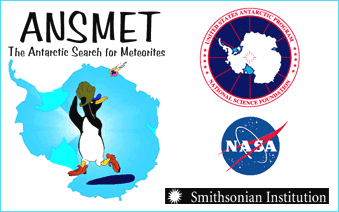
|
Searching Antarctic Ice for Meteorites
Written by Linda M.V. Martel |
For a twenty-fifth austral summer, the Antarctic Search for Meteorites (ANSMET) program sent a team of people from far-flung homes to the ice to search for meteorites. From Dec. 7, 2001 to Jan. 23, 2002 we camped at Meteorite Hills and traversed by snowmobiles to the surrounding ice fields where we searched, sometimes on foot, in systematic parallel sweeps. Led by Principal Investigator, Ralph Harvey of Case Western Reserve University (CWRU, Cleveland), the team members were: John Schutt (Co-I and mountaineer from Washington state), Jamie Pierce (Summit Expeditions mountaineer, Seattle), Nancy Chabot (ANSMET post-doc at CWRU), Cari Corrigan (CWRU), Matthew Genge (Natural History Museum, London), Duck Mittlefehldt (NASA Johnson Space Center, Houston), Juanita Ryan (NSF's Teachers Experience Antarctica program, San Jose), Maggie Taylor (NASA Jet Propulsion Laboratory, Pasadena) and me, Linda Martel (University of Hawai'i). Our efforts added 336 meteorites (from as small as 1-centimeter long to almost 30-centimeters long) to the world's collection of extraterrestrial bits and pieces. Whether these meteorites are collisional debris from asteroids or from high-energy impacts on the Moon or Mars awaits to be seen.
Reference:
U. S. Antarctic Search for Meteorites program.
Support
ANSMET meteorites represent the materials making up the solar system. The unbiased and uncontaminated sampling of meteorites recovered from the Antarctic ice sheet provides researchers with "ground truth" about the materials and formation conditions of the solar nebula, asteroids, moons, and planets. Taking these rocks from space off the ice and into the laboratory is crucial to our quest to understand the history and composition of the solar system we live in. ANSMET makes annual expeditions to Antarctica to provide this much-needed continuous and readily available supply of extraterrestrial materials. See the ANSMET Frequently Asked Questions for more details on how ANSMET meteorites have helped advance planetary science.
ANSMET is funded through a partnership among the National Science Foundation, NASA, and the Smithsonian Institution. For the 2001-2002 season, ANSMET was one of twenty-six Antarctic activities supported by the Geology and Geophysics program of the Office of Polar Programs at the National Science Foundation. Our NSF program manager, Scott Borg, was in McMurdo when I arrived. Increased NASA funding this season, through program manager Joe Boyce, enabled our team to have ten members rather than the usual eight.
Logistics for a season in the sun
After leaving home, our expedition team members converged in Christchurch, New Zealand home to the New Zealand, Italian, and U. S. Antractic programs. Officials at the Clothing Distribution Center briefed us on Extreme Cold Weather (ECW) clothing and issued about 40 pounds of it to each of us. We were outfitted with layers of long underwear, fleece shirt and pants, heavy wind pants, down-filled parka, double-insulated boots, goggles, neck warmers, hats, and more mittens and gloves than you could count.
Flights south to McMurdo Station (77o 51' S, 166o 40' E) are handled by the U.S. Air National Guard or Royal New Zealand Air Force with LC130 Hercules cargo planes. The canvas-webbing seats, noise, and dark spaces of the plane were new experiences for me. It was all in stark contrast to the nearly blinding white snow and ice of the landing field at McMurdo.
The season began with a planned staggered start allowing the two mountaineers, John Schutt and Jamie Pierce, to arrive first at McMurdo in mid-November. McMurdo is one of three U. S. year-round stations on the Antarctic continent. The other two stations are Amundsen-Scott South Pole and Palmer. According to NSF reports the U. S. Antarctic Program (USAP) supported 800 researchers in Antarctica this year participating in approximately 148 different research projects. Over 2,000 civilian contract employees and U.S. military personnel supported these projects on the continent. It can't be over emphasized how crucial their support is for the transport and ultimate well being of each and every soul and piece of equipment out on the ice. Our team relied on the expertise of Steve Dunbar, Alana Jones, and Robbie Score from NSF's polar contractor, Raytheon Polar Services.
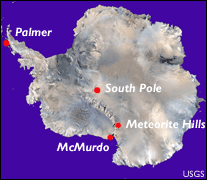 |
AVHRR satellite image composite showing locations of year-round U. S. stations and Meteorite Hills. |
In McMurdo, John Schutt and Jamie Pierce began the lengthy preparation, loading, and unloading of gear and supplies for the team's entire seven-week field season. As described by Jamie in one of his ANSMET journal entries, the necessities for five men and five women in the deep field of Antarctica included: 1900 pounds of food, eight snowmobiles, over 5000 gallons of fuel, four meteorite collection kits, four Scott polar tents for dwellings, one old polar tent for the outhouse, one group tent, stoves, cook kits, sleep kits, radios, GPS units, a satellite phone, laptops, cameras, batteries, solar panels, wind turbine, sleds, maps, satellite images, ice chippers and axes, rock hammers, ropes, bungee cords, knee pads, bamboo poles, buckets, boxes and bags, survival gear, and personal gear. All the other team members except for me arrived in McMurdo on Nov. 30, 2001 for training and preparations. They deployed to the remote field camp by Twin Otter airplane on Dec. 7. Jamie stayed longer in McMurdo in order to meet my arrival from Christchurch and prepare me for Meteorite Hills.
Our tent camp at Meteorite Hills (79o 38' S, 155o 41' E) was organized for eight people at a time, so Jamie and I were geared up to swap places with Ralph Harvey and Juanita Ryan. The same Twin Otter plane that brought Jamie and me into camp on Dec. 21 also took out John Schutt and Duck Middlefehldt to the Finger Ridges ice fields about 55 kilometers away for a short reconnaissance mission. They returned to camp on Dec. 26, the same day that Ralph and Juanita left for home. This shifting of teammates allowed me to be in camp for 34 days. Six intrepid members, Cari Corrigan, Duck Middlefehldt, John Schutt, Maggie Taylor, Matt Genge, and Nancy Chabot, were in camp for the entire 48 days.
Special aspects of life on the polar plateau
ANSMET camps are self-sufficient with equipment, gear, fuel, and food. Boxes of frozen food (meats, seafood, vegetables, fruit, cheese, rice, breads, chocolate bars, soups, etc.) sat outside each tent, some items needing only a quick thaw at the top of the stove-heated tent before cooking. A bucket of ice chips in each tent was not an option as thermoses and water bottles needed constant refilling. We required no permanent or semi-permanent structures, but two special tents added for the first time stand out in my mind: a group tent, which housed a laptop and Iridium satellite phone, and an outhouse tent. The Iridium's mobile phone system worked very well from our remote location. Voice and data from Meteorite Hills were relayed by one of 66 orbiting Iridium satellites to ground stations which then relayed to public telephone networks. In addition to the phone, we had the usual HF radios issued to remote field parties. The HF radios, which operate by bouncing high frequency signals off the ionosphere from transmitter to receiver, were affected more than once by solar flare activity during the field season. When the HF radios were inoperable, our communications with McMurdo were made with the satellite phone.
The weather and snowmobiles seemed to dictate our every move. Bright and cloudless calm-wind days were interrupted by unprecedented high winds and overcast snowy days. Winds howled at 80 kilometers per hour and blasted up to 160 kilometers per hour for days at a time. I will never forget sitting in the tent with Nancy listening to the noisy pandemonium of those winds. We spent roughly 50 percent of the field season tent bound due to bad weather or in camp waiting for the arrival of a Twin Otter plane. And 50 percent of our snowmobiles (four of eight) became disabled during the last day of fieldwork after a season of repairs and replacements of bogie wheels, spark plugs, and skis.
Collection procedures
During the systematic searches and sweeps we used only our eyes to scan the blue ice, sometimes with the aid of binoculars. Forming a line either on snowmobile or on foot we worked by moving in parallel transects spaced apart according to the terrain and concentration of meteorites. We searched back and forth for hours and hours with backs to the wind and faces in the wind to find dark objects on the ice. They turned out to be, more often than we liked, shadows or terrestrial rocks dumped by glaciers. The fun began when someone spotted a meteorite and waved his or her arms to signal the rest of the team to converge at the find. It had to be a big physical movement because we were usually too far away from each other astride noisy snowmobiles, buffeted by winds, to hear any voices.
A snowmobile with a GPS receiver parked next to the meteorite to record about five minutes of location data and a collection bag was brought out. It held sterile Teflon bags, Teflon tape, stainless-steel tongs, number counter, and aluminum number tags. Each meteorite was given a unique field number that was logged in the notebook along with the rock's size and estimate of fusion crust and preliminary classification. Any outstanding characteristics of the meteorite or unusual collection details were also noted (for example, if the rock had an unusual color or was inadvertently touched.)
Next came an official digital photograph of each meteorite with the counter held behind it showing the field number. Data logging during our field season was handled by John, Ralph, Nancy, and Jamie. We all used the sterile tongs to pick up the meteorites and place them into sterile Teflon bags. Each bag was taped securely. A bamboo flag pole marked with the field number was positioned at each meteorite's location as a backup in case something went wrong before or during the transfer of GPS data to John's laptop back in camp. Workdays typically ran eight to nine hours long--painstaking work by motivated and persistent seekers with good senses of humor. On the best days, the team found 20 or more meteorites, but some days we only netted three or a half dozen. The finally tally of 336 meteorites came from ice fields around Meteorite Hills (326 specimens), Finger Ridges (6), from a science group at Mt. Crean (1), and from another group at Odell Glacier (3).
Clean, cold storage
With superb clothing, shelter, gear, knowledgeable and experienced leaders, and dedicated teammates, it was almost easy for me to forget I was living in an extreme environment. We had ready access to calorie-packed food that was easy to prepare, we had email, and a phone! Then reality would hit: icy winds whipped up, the wind turbine roared, I had to go, I couldn't take a shower or it was time to drive the snowmobile over sastrugi--those dreaded wind-sculpted crusted snow dunes. There was no doubt I was out of my normal habitat. I was living in a windy freezer.
It is this very environment that helps make Antarctica an ideal place to recover rocks from space. They are in clean, cold storage. Meteorites that have been falling on the surface through the millennia become buried in the ice moving slowly seaward. At mountains or subsurface obstructions, the forward movement of the ice is blocked. Old deep ice, laden with meteorites, is pushed up to the surface against the barriers. Dry (sometimes brutal) katabatic winds (winds blowing down the slopes) clear the surface of snow and aid sublimation and mechanical erosion which expose the meteorites on what we call stranding surfaces. The desert conditions of Antarctica help to preserve meteorites that would otherwise weather away under more humid settings. The blue and white background and relative lack of terrestrial sediments make it easier to spot dark meteorites on the stranding surfaces than in a forest or farmer's field.
We made genuine efforts to keep every meteorite clean, by doing our best to collect them without touching them with hands, gloves or tools. We mostly towed the line, though there were a few mistakes, like the time I accidentally drove over one (which was duly noted in the notebook.) As for cold storage, the meteorites were collected frozen, stored and shipped frozen, and will finally be thawed under clean room conditions at the Antarctic Meteorite Curation labs at NASA's Johnson Space Center.
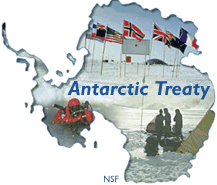 |
The removal of rock specimens is strictly controlled by the Antarctic Treaty (signed by 44 nations representing about two-thirds of the world's population) which says that specimens of any kind can only be removed for scientific research. The recovered ANSMET meteorites fall under this category and are the responsibility of the National Science Foundation. Under a three-agency agreement, NASA supports initial characterization, curation, and the distribution and notification of samples. The Smithsonian Institution assists in sample characterization and provides for long-term curation. Image courtesy of the National Science Foundation. |
After thawing, each meteorite will be examined, cracked open, and small pieces will be broken off for study as thin sections under a microscope. From these initial characterizations, short descriptions will be written up and distributed in the bi-annual publication called the Antarctic Meteorite Newsletter. Descriptions of the 2001-2002 Meteorite Hills meteorites will begin appearing in the Newsletter in late summer 2002, with names beginning with MET01xxx. The worldwide distribution of these samples to interested researchers is guided by the Meteorite Working Group, a peer group of meteorite experts.
Post-season reflections
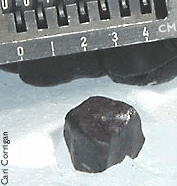 |
Our collection of 336 meteorites is near the season average number of 350. According to ANSMET records, individual season totals have varied from 30 (in 1976-77) to more than 1000 meteorites (in 1987-88, 1997-98, and 1999-2000). In all, roughly 11,000 Antarctic meteorites have been found by ANSMET teams during the past 25 years. The total reaches nearly 25,000 when Japanese and European collections are included.
The February 2002 Antarctic Meteorite Newsletter contains a brief description of our season written by Ralph Harvey. Of the 336 meteorites collected from all sites this season, he reports from his notes that 308 are ordinary chondrites, 10 are achondrites, 11 are carbonaceous chondrites, 2 are irons, and 5 are as yet unclassified. David Kring (University of Arizona) provides a nice on-line overview of meteorites and their properties. The launch of the ANSMET expedition website was a huge success thanks to webmaster Tim Harincar, creator of WebExpeditions. Our daily journal entries and photos from the field reached about 25,000 website visitors. Tim reports that one hundred and twenty-four subscribers received our journal updates via email. And that doesn't even count all the classrooms and offices full of people back home who we knew were asking, "How many did they find today?" Our communication links in the field were more than technological wonders. They were, to borrow a phrase from Ralph, lifelines. |
Since returning to Honolulu, I am adding the Antarctic meteorites story to my usual education and public outreach activities. It is a vital responsibility of the scientific community to share the fascinating discoveries being made by planetary exploration and the research being done on extraterrestrial materials. Talking with students, teachers, and the public also lets me relive the experience of working with a group of wonderful people in an incredible place, one of Earth's last frontiers. I speak about the search and recovery of meteorites and the role these specimens play in shaping what we understand about the formation of our solar system. My stories are also about cool science careers, great teamwork, and how the most extraordinary dreams can come true for ordinary people. When the School of Ocean and Earth Science and Technology at the University of Hawaii has its Open House in April one thousand school kids will be on campus and will see our popular meteorite activities. I'll be there in a Scott tent mock-up with genuine Extreme Cold Weather clothes (on loan from Raytheon... nope, I won't be actually wearing them in this heat) ready to share the experience of searching for meteorites in Antarctica. Can't wait to see their wide eyes twinkle.
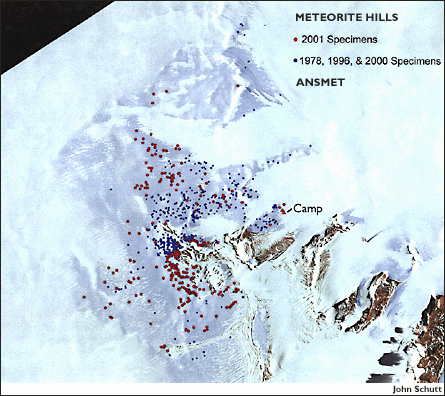 |
This satellite image of Meteorite Hills shows the locations of our camp and meteorites found during our season (2001) and previous seasons (1978, 1996, and 2000.) |
|
|
[ About PSRD |
Archive |
Search |
Subscribe ] [ Glossary | General Resources | Comments | Top of page ] |